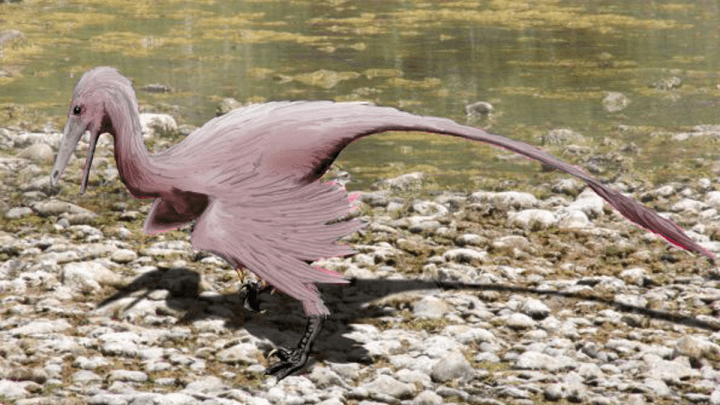Dinosaurs related to Velociraptor evolved the ability to fly at least several times. That’s what a new study by University of Hong Kong paleontologist Michael Pittman and colleagues suggests.
Although we’ve long believed dinosaurs couldn’t fly, it appears several species could or were near that point.
“Flight is not something dinosaurs were traditionally expected to do,” says Pittman.
According to Pittman, relatives of the raptors in the dromaeosaurid family evolved potential for powered flight at least twice. Previously, scientists believed only gliding flight was evolving, but now they believe the creatures had the potential to leap into the air and fly, not merely glide.
“So, what we found in our reconstruction is that across early birds and their closest relatives, the potential for powered flight actually originates at least three times: Once in early birds, and twice in the raptors or dromaeosaurids,” Pittman explained.
Imagine a World of Flying Raptor Dinosaurs
In the study abstract, Pittman says the most significant finding was that “most ancestors of bird relatives came close to the threshold of powered flight potential.”
Thus, multiple dinosaur species were nearly at the point of flying before the mass extinction event 66 million years ago. One wonders what would have happened if the extinction event had not taken place? Perhaps, we’d see a world of various flying raptors? On the other hand, probably not, because early humans may not have survived such a scenario!

Dinosaur Lineages with Powered Wings
According to the study, these deinonychosaur lineages had wings capable of or nearing powered flight:
- The bird-like Rahonavis
- Four-winged raven-like Microraptor
- Bambiraptor and Buitreraptor (nearing flight ability)

As Smithsonian’s Riley Black put it:
“Flight wasn’t just for the birds, in other words. Many non-bird dinosaurs were evolving aerodynamic abilities, but only a few were able to actually flap their wings and fly.”

See the Microraptor from BBC Earth below (made before the latest study about powered flight):
Flight Not Such a ‘Rare Gem’ of Evolution
Significantly, the study indicates that flight was not limited to early bird lineage alone but much more widespread. Thus, as the dinosaurs were flapping their feathered wings, they may have been literally stumbling upon the ability to fly.
“…This is really important because it suggests that there was broad experimentation in the use of the feathered wings in assisting locomotion before the evolution of flight,” he says.
Related: Anole Lizards That Act Like Scuba Divers With Natural Oxygen Tanks
Rather than being an “exclusive club,” the researcher suggests, “This moves away from the traditional idea that flight is a rare gem.”

As these dinosaurs were chasing prey, feathered wings helped propel them along, flapping and fluttering along. Given more time, they, too, may have taken to the air. However, only the beaked birds managed to survive when a meteor most likely wiped out the dinosaurs.
Perhaps, the birds, further along in their flight abilities, had a critical edge to survive the catastrophe? One wonders, but for now, we can only speculate.
Studying the Aerodynamics of Feathered Dinosaurs
To determine how early dinosaurs were nearing flight potential, paleontologists have used new methods to look at feathered dinosaurs and fossils. According to Smithsonian, the scientist borrowed engineering techniques to study the dinosaur’s aerodynamic abilities.
For example, scientists previously used laser-stimulated fluorescence imaging to evaluate the anatomy of theropod dinosaurs with bat-like membranous wings. By using laser, they could reconstruct never-before-seen details of fossils in color.
In the therapod studies, it appeared they could only crudely glide along after jumping from trees. Thus, the flapping motion to propel flight wasn’t there. Consequently, the researchers called it an evolutionary dead-end and “a failed experiment in pre-bird theropod flight.”
Related: Adolescent Tyrannosaurus rexes made life hell for prey that could escape slower adults
Below, Dr. Pittman discussed laser simulated fluorescence in paleontology via TEDx Talks:
Will Paleontologists Find More Flying Dinosaurs?
As noted, Pittman and colleagues found more potential in the raptor species that may have leaped from the ground or trees to take flight like today’s birds. In those dinosaurs, the “anatomical hallmarks of powered flight” were there, as Smithsonian states.
Additionally, the researchers also used an evolutionary classification called cladistics, first used in the 60s. By grouping animals with shared traits, the researchers gain a clearer picture of which species are most closely related to one another.
As more fossil discoveries are made, it’s possible paleontologists might find more examples of flying dinosaurs not related to early birds.
Fortunately for all of us, they have wiped out millions of years ago. Imagine living in a world with many types of flying predatory dinosaurs in the skies. Today, most of us enjoy a pleasant experience birdwatching the dinosaurs’ remaining relatives, the birds.
More fun imagining the biggest thing that ever flew from PBS Eons:
Featured image: Screenshot via YouTube


